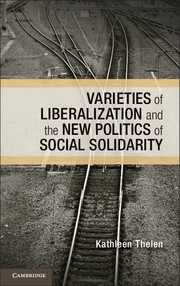Book contents
- Frontmatter
- Dedication
- Contents
- List of Figures
- List of Tables
- List of Abbreviations
- Preface
- 1 Varieties of Liberalization and the New Politics of Social Solidarity
- 2 Industrial Relations Institutions
- 3 Vocational Education and Training
- 4 Labor Market Policy
- 5 Coalitional Realignments and Institutional Change
- 6 The Future of Egalitarian Capitalism, in Light of Its Past
- Appendix A Components of Index and Descriptions of Variables for Figure 1.1
- Appendix B Components of Index for Figures 6.2 and 6.3
- Bibliography
- Index
Preface
Published online by Cambridge University Press: 05 June 2014
- Frontmatter
- Dedication
- Contents
- List of Figures
- List of Tables
- List of Abbreviations
- Preface
- 1 Varieties of Liberalization and the New Politics of Social Solidarity
- 2 Industrial Relations Institutions
- 3 Vocational Education and Training
- 4 Labor Market Policy
- 5 Coalitional Realignments and Institutional Change
- 6 The Future of Egalitarian Capitalism, in Light of Its Past
- Appendix A Components of Index and Descriptions of Variables for Figure 1.1
- Appendix B Components of Index for Figures 6.2 and 6.3
- Bibliography
- Index
Summary
This book was motivated by an interest, empirical and normative, in the continued viability of what we have traditionally thought of as the more egalitarian or “social” variety of capitalism found in much of Europe. The institutions that define this alternative model are widely seen as under siege as a result of myriad pressures associated with globalization and deindustrialization. I was interested to learn more about the changes these pressures have wrought, and what possibilities existed for preserving social solidarity in a neoliberal era. A vast literature on the welfare state has taught us a great deal about recent developments in social policy and welfare institutions. Rather than go over this well-tilled ground, I decided to focus on other arrangements that have not figured prominently in the welfare state literature but that do occupy a central position in a different but related body of scholarship, on varieties of capitalism (VofC). Specifically, I explore developments in three institutional realms – industrial relations, vocational education and training (VET), and labor market institutions – that the VofC literature sees as distinguishing the so-called coordinated market economies (CMEs) in Europe and Japan from the liberal market economies (LMEs) of the Anglo-Saxon world.
From the beginning, the VofC literature challenged the idea that contemporary market pressures would drive a convergence on a single best or most efficient model of capitalism. The idea at the very heart of the VofC framework was to insist instead that these two models represent different ways to organize capitalism; each has its own distinctive competitive strengths, and both are durable even in the face of new strains. This has been a reassuring argument for those of us who might otherwise worry about the breakdown of institutions characteristic of the CMEs, which are widely seen as supporting the “gentler” form of capitalism, rather than the alternative “cutthroat” Anglo-Saxon model (Bohle and Greskovits 2009; Acemoglu et al. 2012). Despite the reassurances, however, the fact is that we do observe serious strains and significant changes across all three of the institutional arenas under analysis here, not only and certainly not least in the CMEs. So the question to which this book is devoted is whether the trends we are observing are driving a convergence on the more inegalitarian LME model after all.
- Type
- Chapter
- Information
- Publisher: Cambridge University PressPrint publication year: 2014

